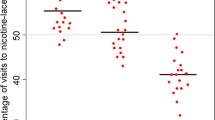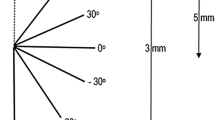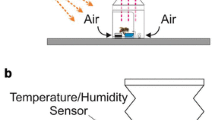Summary
Fluid viscosity only affected ingestion rates of bumble bees (Bombus) for solutions greater than 35–40% sucrose (mass of solute per mass of solution). This contrasts with previously published models based on fluid dynamics which predicted continuous depression of ingestion rates with increasing viscosity. Individual bees maintained constant lapping rates regardless of sucrose concentration (up to at least 70%). The decline in ingestion rates at higher concentrations apparently resulted from the tongue not contacting liquid long enough to become saturated due to reduced capillary flow. Increasing flower depth similarly decreased the volume of liquid ingested per lap, and did not affect lapping rate. Morphologically dissimilar bees drank at different rates because glossa length affects lapping rate and volume ingested per lap, and body mass affects lapping rate. An additional species-specific component to lapping rate also influenced ingestion rates. Deviations from a regression model derived to explain ingestion rates as a function of glossa length, body mass, flower depth and liquid viscosity suggest mechanistic and behavioralaspects to flower probing time. Because of the relation between ingestion rate and liquid viscosity, the sucrose concentration maximizing a bee's rate of net energy uptake should lie between 50–65%, depending primarily on specific conditions of nectar volume, inflorescence size and flight time between inflorescences.
Similar content being viewed by others
References
Baker HG (1975) Sugar concentrations in nectars from hummingbird flowers. Biotropica 7:37–41
Bertsch A (1984) Foraging in male bumblebees (Bombus lucorum L.): maximizing energy or minimizing water load? Oecologia (Berlin) 62:325–336
Bitterman ME (1976) Incentive contrast in honeybees. Science 192:380–382
Ewald PW, Williams WA (1982) Function of the bill and tongue in nectar uptake by hummingbirds. Auk 99:573–576
Hainsworth FR (1973) On the tongue of a hummingbird: its role in the rate and energetics of feeding. Comp Biochem Physiol 46A:65–78
Hainsworth FR, Wolf LL (1976) Nectar characteristics and food selection by hummingbirds. Oecologia (Berlin) 25:101–113
Harder LD (1982) Measurement and estimation of functional proboscis length in bumblebees (Hymenoptera: Apidae). Can J Zool 60:1073–1079
Harder LD (1983a) Flower handling efficiency of bumble bees: morphological aspects of probing time. Oecologia (Berlin) 57:274–280
Harder LD (1983b) Functional differences of the proboscides of short- and long-tongued bees (Hymenoptera: Apoidea). Can J Zool 61:1580–1586
Harder LD (1985) Morphology as a predictor of flower choice by bumble bees. Ecology 66:198–210
Hartling LK, Plowright RC (1979a) An investigation of inter- and intra-inflorescence visitation rates by bumble bees on red clover with special reference to seed set. Proc IVth Int Symp on Pollination, Md Agric Exp Stat Spec Misc Publ 1:457–460
Hartling LK, Plowright RC (1979b) Foraging by bumble bees on patches of artificial flowers: a laboratory study. Can J Zool 57:1866–1870
Hemrich B (1975) Thermoregulation in bumblebees II. Energetics of warm-up and free flight. J Comp Physiol 96:155–166
Heinrich B (1979) Resource heterogeneity and patterns of movement in foraging bumblebees. Oecologia (Berlin) 40:235–245
Heyneman AJ (1983) Optimal sugar concentrations of floral nectars—dependence on sugar intake efficiency and foraging costs. Oecologia (Berlin) 60:198–213
Hodges CM (1981) Optimal foraging in bumblebees: hunting by expectation. Anim Behav 29:1166–1171
Hodges CM (1985) Bumble bee foraging: the threshold departure rule. Ecology 66:179–187
Hodges CM, Wolf LL (1981) Optimal foraging in bumblebees: why is nectar left behind in flowers? Behav Ecol Sociobiol 9:41–44
Kingsolver JG, Daniel TL (1983) Mechanical determinants of nectar feeding strategy in hummingbirds: energetics, tongue morphology, and licking behavior. Oecologia (Berlin) 60:214–226
May PG (1985) Nectar uptake rates and optimal nectar concentrations of two butterfly species. Oecologia (Berlin) 66:381–386
Montgomerie RD (1984) Nectar extraction by hummingbirds: response to different floral characters. Oecologia (Berlin) 63:229–236
Morse DH (1980) The effect of nectar abundance on foraging patterns of bumble bees. Ecol Ent 5:53–59
Neter J, Wasserman W (1974) Applied linear models. Irwin, Homewood, Illinois
Pivnick KA, McNeil JN (1985) Effects of nectar concentration on butterfly feeding: measured feeding rates for Thymelicus lineola (Lepidoptera: Hesperiidae) and a general feeding model for adult Lepidoptera. Oecologia (Berlin) 66:226–237
Plowright RC, Laverty TM (1984) The ecology and sociobiology of bumble bees. Ann Rev Ent 29:175–199
Pouvreau A (1974) Le comportement alimentaire des bourdons (Hymenoptera, Apoidea, Bombus Latr.): La consommation de solutions sucrées. Apidologie 5:247–270
Pyke GH (1978) Optimal foraging: movement patterns of bumblebees between inflorescences. Theor Pop Biol 13:72–98
Pyke GH, Waser NM (1981) The production of dilute nectars by hummingbird and honeyeater flowers. Biotropica 13:260–270
Roubik DW, Buchmann SL (1984) Nectar selection by Melipona and Apis mellifera (Hymenoptera: Apidae) and the ecology of nectar intake by bee colonies in a tropical forest. Oecologia (Berlin) 61:1–10
Snodgrass RE (1956) Anatomy of the honey bee. Comstock, Ithaca NY
Waddington KD (1983) Foraging behavior of pollinators. In: Real L (ed), Pollination biology. Academic Press, New York, pp 213–239
Waller GD (1972) Evaluating responses of honey bees to sugar solutions using an artificial-flower feeder. Ann Ent Soc Amer 65:857–862
Whitham TG (1977) Coevolution of foraging in Bombus and nectar dispensing in Chilopsis: a last dreg theory. Science 197:593–596
Woodrow AW (1968) Some factors affecting selection of sucrose solutions by foraging honey bees. Amer Bee J 108:313–315
Author information
Authors and Affiliations
Rights and permissions
About this article
Cite this article
Harder, L.D. Effects of nectar concentration and flower depth on flower handling efficiency of bumble bees. Oecologia 69, 309–315 (1986). https://doi.org/10.1007/BF00377639
Received:
Issue Date:
DOI: https://doi.org/10.1007/BF00377639




